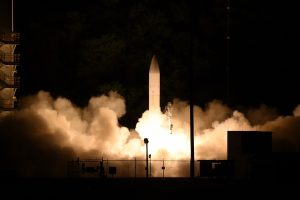The United States Air Force revealed this week that it will conduct a flight test of an air-launched hypersonic missile in December, before the weapon goes into production next year. It will be the first hypersonic weapon deployed by the U.S. military.
Will Roper, the air force’s top weapons and research official, told a defense forum this week that they will test the booster rocket of the Air-launched Rapid Response Weapon (ARRW) later this month before the prototype weapon goes into full production next year. In August, the air force successfully tested that the ARRW integrated correctly with a B-52 bomber’s launching system, the final stage before a live launch test.
The ARRW is an air-launched boost-glide hypersonic weapon, meaning that the weapon’s warhead is initially accelerated using a rocket before gliding unpowered to its target at speeds greater than five times the speed of sound. Some observers speculate that the ARRW could be much faster than even low hypersonic speeds and could travel closer to 20 times the speed of sound.
The air force expects the ARRW to be operational and deployable before the end of 2022, making it the first hypersonic weapon to enter the U.S. military’s arsenal.
The U.S. Army and U.S. Navy are also working on a boost-glide hypersonic weapon based around a common warhead and rocket design. The air force had been a part of this tri-service effort but abandoned its air-launched version earlier this year to focus funding on the ARRW design.
The army is planning to deploy its ground-launched hypersonic weapon in 2023. Limited deployments of the navy’s submarine-launched version may be ready in 2025, before a full deployment scheduled for 2028.
The air force is also working on a hypersonic cruise missile and is evaluating two designs of the Hypersonic Air-breathing Weapon Concept (HAWC) to flight test within the next calendar year. Unlike ARRW or the army and navy weapons that are essentially high-speed gliders, the HAWC designs use an advanced scramjet to propel the weapon in flight from launch to impact with its target. Unlike traditional jet engines, scramjets do not have mechanical fans to compress the air before combusting it with fuel; instead they rely on the engine’s high speed alone to compress the air internally and combust it at supersonic speed.
Russia successfully tested its scramjet-powered sea-launched hypersonic anti-ship missile, the Zircon, several times this year. China began deploying a ground-launched boost-glide hypersonic weapon, the DF-17, last year, and is also believed to be making progress towards a scramjet-powered weapon.

































